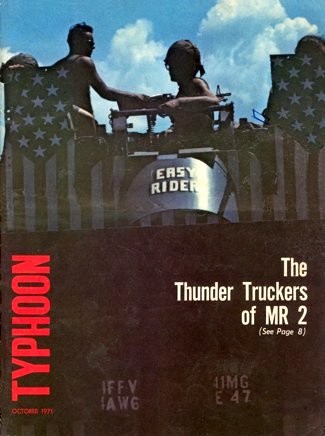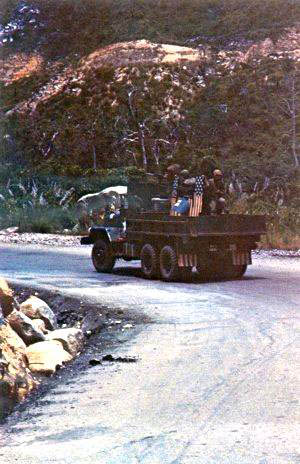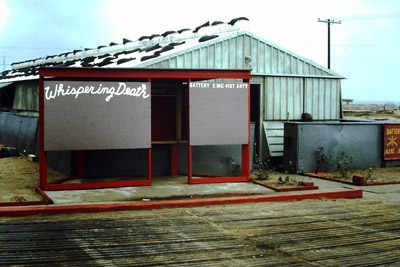Vietnam Central Highlands, 1971 The following article was the cover story in the October 1971 issue of TYPHOON magazine (Vol. V, No. 3), an "in-country rag." from the inside cover:
|
 |
"Hit 'em in the logistics," a general once said
about the enemy. But before he said it,
he made sure his own convoy teams
were staffed with shutout pitching.
TRAILBOSS

Ten spinning tires slap the asphalt of QL I. They carry a silent but deadly cargo amid a speeding convoy transporting supplies to one of the allied units stationed throughout Military Region 2.
The 10 tires roll beneath a U.S. Army 5-ton truck. About 3,000 pounds of whispering thunder rests in the truck's cargo bed in the form of four 50-caliber machine guns paired over-under style on a single mount.
Easy Rider, Southern Comfort, American Breed, A Whole Lot o' Lead, all are quad 50 machinegun convoy escort trucks that belong to E Battery, 41st Air Defense Artillery. This Tuy Hoa based battery, popularly known as the "bastard" unit of Second Regional Assistance Group Artillery because it totes 50-caliber machine guns instead of 105mm Howitzers, provides convoy protection and perimeter security daily to 11 installations and firebases throughout Military Region 2.
With 25,000 square miles of every type of terrain imaginable for an area of operations, E Battery manages to keep pretty busy, according to Captain Thomas L. Baily, E Battery commander.
The number of convoy escort missions provided by the battery varies each month. In June, three sections alone convoyed with 31 separate missions, and sometimes the crews operated in a pinch.
That's another way to say that they had little sham time. One crew, for instance, was called upon to provide protection for a two day resupply convoy. When they arrived at the destination, the installation was on "red" alert and the quads took up perimeter security all night with double shifts. The next day, the quads escorted the convoy on the two day return trip. Crew members ate and slept on their vehicles, sometimes performing weapons maintenance on the run.
How does the work load affect the morale of the quad 50 team members? Apparently the more work, the better.
"I've been real, real lucky so far," Baily said. "My men take pride in their guns as well as in their missions. I've got E 5s doing jobs that lieutenants do, and usually I don't get word about a mission until it's all over and they're calling in an after action report.
"If they get clearance to fire on a mission, you don't have to ask them twice. They'll spray hell out of everything," he added.
And what does it take to be a crewman on the quads? The members of Easy Rider Southern Comfort section stationed at Camp Wilson have most of the answers.
"A lot of guts and no brains'' joked one of Easy Rider's crewmen. He drew a few boo's from the rest of the two crews standing around him.
"The quads can do anything if they have to," commented PFC Mike Walsh from sister gun truck Southern Comfort.
"There it is," chorused a few.
"I wouldn't want to be any other place in Vietnam but on that truck. If I'm going to make it home, it will be because of that truck," another chimed in.
"We just have to make sure everybody has his field jacket and pot on. You've got to keep your sierra together. "
Speaking was Southern Comfort's crew chief and section NCOIC, Walter Miller of Montezuma, Ga. He was assigned to the quads in May, and it didn't take long for him to adapt to the roadrunner pace.
"For every eight hours on the road, we usually pull at least three hours of maintenance," he said. "When we're not doing anything except base camp security, we can work six hours a day on the vehicle and the guns."
Miller added that performing vehicle maintenance is one of the most difficult tasks in the section.
The quads receive third echelon maintenance readily if it is available wherever they go. But in pulling operator crew and organizational maintenance themselves, it is often hard to get needed replacement parts simple things like a new speedometer or a "cold" tire repair kit because of the section's nomadic missions.
"When we get above 10 per cent deadline," Baily added, "all hell breaks loose. But until then, you don't hear anything good or bad as long as the trucks are running. "
 Both statements partially reflect the importance placed on the fire support and shock
effect that the quads make available. The enemy tends to stay away from the quads' sectors of fire in perimeter night defensive positions. And on the road, the brightly colored gun mounts
are recognized as law 'n order badges rather than as easy targets by the enemy.
Both statements partially reflect the importance placed on the fire support and shock
effect that the quads make available. The enemy tends to stay away from the quads' sectors of fire in perimeter night defensive positions. And on the road, the brightly colored gun mounts
are recognized as law 'n order badges rather than as easy targets by the enemy.
There is a certain excitement, a natural feeling of confidence, that spreads over each quad crew on convoy escort missions. And it is reassuring to them to wheel unhampered through a potentially dangerous pass with a convoy when only a week before another convoy without their escort was plagued with enemy harassing fire.
There also appears to be a certain amount of respect for the 10-ton thunder truckers among the friendly Vietnamese populace. Passing through the villages, Vietnamese adults silently watch the convoy roll on while the kids wave at all the vehicles. When the quads pass in review, the kids gape in awe and flail their hands more vigorously while the adults follow with their eyes the path of each quad until it is obscured from sight.
A day in the firebase is somewhat less exciting. The wind that blows a man's nose back against his face as he looks sidelong from the rear deck of a quad escort on the move no longer exists and the resulting heat is oppressive. When it becomes too dark to pull maintenance, guard duty is the only job left. It lasts all night.
But the chow is good at Firebase Wilson anyway. And Miller's crews do find things to do to pass away their free time. In the late afternoons, they can watch the Koreans stationed on the same perimeter lift heavy weights as though they were barrens on toothpicks. That's only a warm up for an occasional Taekwando demonstration, judo Korean style.
Or the enlisted men and NCOs from the artillery battery down the hill may bring their small arms weapons up to the test fire range near the Southern Comfort crew's hootch for some target practice at the mud puddles below them in the valley.
When Easy Rider and Southern Comfort get together for such an exercise, they create a firepower demonstration that brightens the twilight with trails of red tracers. The racket created by the spitting quads sounds like thunder from a marching band of a thousand snare drums. Each quad can lay down 2,000 rounds a minute.
The next day brings more weapons maintenance in the early morning hours. Miller sees that it all goes well.
"I don't have too many command problems," he said. "The people they respect me. I'm the only black man in the section and I like to pitch in and work with the men myself."
He's the boss, but he also changes tires. The men acknowledge that he's the section leader, and they call him "Miller" instead of "sergeant." Miller prefers it that way. He also pulls a shift on guard every night. And when he announces that a mission has just been called in and the trucks have to be on their way to the start point in a half hour, the crews don't have to be told to get with the action. Southern Comfort and Easy Rider have never been late for a mission.
"Sometimes I wonder about these guys," Miller says. "They always want to get on the road."
And the whispering thunder rolls on.
